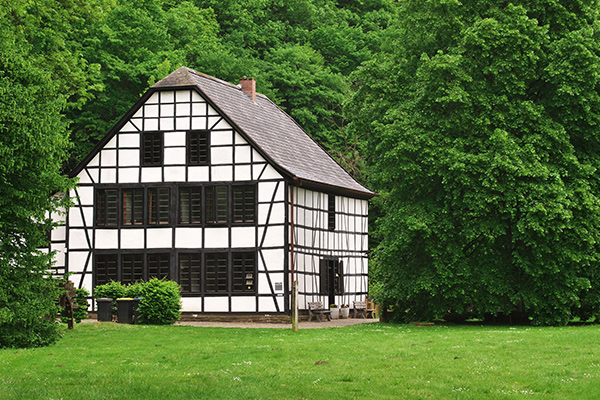As the medieval period evolved we see an increase in the size and technological complexity of the craft processes involved in finishing weapons and armor. In the case of our discussion the blades of swords being manufactured started to be crafted on a larger and larger scale in certain regions or communities. Places such as Solingen and Passau become famous for their quantity and quality of product. Most of these centers of production can be noted as having good access to resources i.e. iron, wood(charcoal) and water for power.
Waterpower becomes essential to the production of the metal objects as it can run large and powerful hammers as well as a variety of finish grinders in a small area with great efficiency. We have some art that depicts such setups as seen below and illustrations that enlighten us to their ingenuity even in cases where they may not have had the topographical setup for a mill style wheel.



Where mills were not feasible on the riverside or more mills were needed, the use of floating mills anchored mid stream allowed for more production.
We are also blessed with some surviving structures where a bit of the technology of the past survives to us today. The wheels that were used in these facilities where not only stone wheels, but quite interestingly, renewable technology of wood and leather to create a long-lasting tool that could be maintained and adjusted as needed. A stone wheel would wear a bit with each grinding and over time get used up. These wood and leather wheels could have the leather replaced as needed and the grinding medium renewed as needed.

A wooden wheel with leather fins for replaceable grinding surface ready for addition of grit. Photo courtesy of Peter Johnson

Wheel with grit filled medium applied to edge. Photo courtesy of Peter Johnson
The set up of the building where these were housed is positioned along a waterpower source and has a couple of floors with progressively finer grinding going on the higher you went in the structure. This kept heavier grits from infiltrating the finer grinding areas and marring the finer surfaces. This technology would allow for very bright finishes to be accomplished and it would be a matter of economics more than ability to what the result would be for the items worked on by these craftspeople.

Balkhauser-Kotten Grinder Museum, Solingen
Here is an excellent video made at the Grinder Museum Balkhauser Kotten that shows some of this great technology that has survived. It is in German but there are some English bits, and it is easy to follow the thread of what they are demonstrating.
In part 4 will talk a bit about sharpening and edges. I also want to thank Dr. S Manning for the questions and correspondence on finishes and polishing.
Check out part 1 and part 2 if you have not seen them.

Nathan Clough, Ph.D. is Vice President of Arms and Armor and a member of the governing board of The Oakeshott Institute. He is a historical martial artist and a former university professor of cultural geography. He has given presentations on historical arms at events including Longpoint and Combatcon, and presented scholarly papers at, among others, The International Congress on Medieval Studies.
Craig Johnson is the Production Manager of Arms and Armor and Secretary of The Oakeshott Institute. He has taught and published on the history of arms, armor and western martial arts for over 30 years. He has lectured at several schools and Universities, WMAW, HEMAC, 4W, and ICMS at Kalamazoo. His experiences include iron smelting, jousting, theatrical combat instruction and choreography, historical research, European martial arts and crafting weapons and armor since 1985
